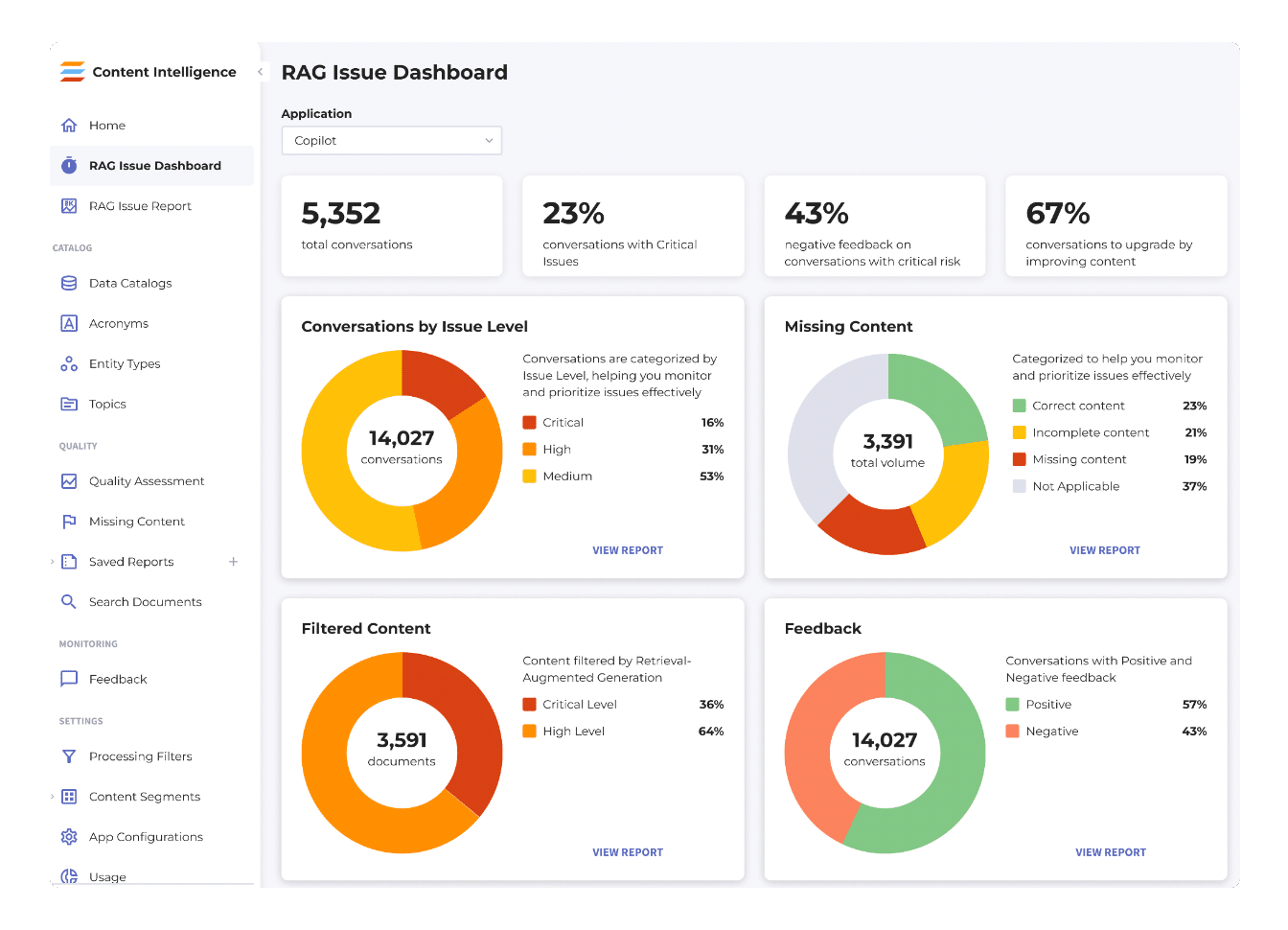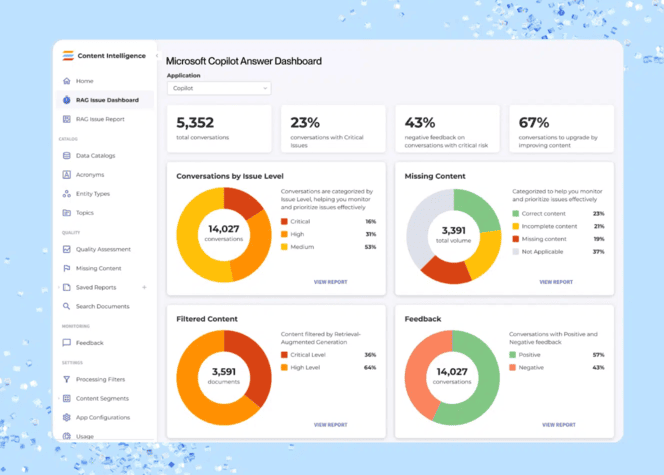Microsoft Copilot is changing the game for teams looking to get more out of their data. But to really see its full potential, your data needs to be prepared thoughtfully—organized, clean, and secure.
Without the right groundwork, you’re setting yourself up for spotty insights, unreliable answers, and, ultimately, frustration.
This guide walks you through everything you need to know to get your data ready for Copilot. With a few strategic steps, you’ll be able to leverage Copilot as the powerful tool it’s meant to be.
What is Microsoft Copilot?
Microsoft Copilot is an AI-powered technology designed to enhance productivity by assisting users through intuitive interactions within a chat interface.
By responding to user prompts and seamlessly integrating into workflows, Copilot helps with tasks like content creation, data analysis, and even strategic planning. It supports a range of user interactions, from drafting emails to summarizing lengthy documents, making it versatile across different functions.
One of the crucial aspects of Copilot’s AI-driven technology is its ability to navigate chat conversations effectively, offering users insightful responses in real time.
Microsoft has taken key steps to minimize risks around harmful content throughout the chat content so that Copilot responds safely and responsibly by using filters and guidelines to manage sensitive or inappropriate prompts. This approach allows users to rely on Copilot for accurate, helpful support while maintaining high standards of safety.
The Importance of Data Quality for Generative AI
To get the most out of Microsoft Copilot—or any generative AI language model—you need high-quality data. Think of it like ingredients for a recipe: Even the best chef can’t create a masterpiece with spoiled produce or stale spices.
Generative AI relies on clean, accurate, and well-organized data to give you the kind of insights and answers that feel intelligent and actionable.
When your data is messy—full of duplicates, gaps, or outdated info—the AI has to work harder to make sense of it, and that impacts the quality of its responses. Data that’s inconsistent or riddled with errors will lead to confusing outputs, irrelevant suggestions, hallucinations, and, ultimately, frustrated users.
Clean data, on the other hand, plays a pivotal role in helping AI algorithms perform more accurately, making sure the insights you get are useful right from the start.
So before jumping into Microsoft Copilot, you need to take some time to check your data quality. With a little preparation upfront, you set the foundation for a smooth, insightful Copilot experience where you can trust the answers it delivers. This is a key element of using any language model.
How to Prepare Your Data for Copilot
Getting your data ready for Microsoft Copilot doesn’t have to be overwhelming, but it does require a bit of strategy. The goal is to make sure your data is structured, clean, and easily accessible so that Copilot can deliver spot-on responses to user inputs. Here’s a step-by-step guide to get your data in shape.

Step 1: Understand Copilot’s Data Requirements
Before diving into data cleanup, it’s crucial to know what Microsoft Copilot actually needs to perform well. Copilot works best when it has a mix of structured and unstructured data that’s relevant, up-to-date, and organized.
Structured data—like numbers, categories, and fields—provides Copilot with a clear framework, while unstructured data—such as documents, emails, and notes—adds context and depth.
Along with the right data types, you’ll also want to ensure that data meets a few essential quality standards. Accuracy, consistency, and completeness are key. Without them, Copilot might end up misinterpreting information or delivering irrelevant results.
Another thing to keep in mind is data security. Sensitive information needs proper handling, both to keep it safe and to ensure compliance with regulations.
Step 2: Organize Your Data Sources
Once you know what Copilot needs, the next step is to organize your data sources. Having data scattered across different platforms—like CRMs, ERPs, and file storage systems—makes it hard for Copilot to pull consistent, relevant information.
Start by identifying all your data sources and cataloging them. This way, you know exactly what you’re working with and where everything lives.
Consider setting up a centralized data repository if you don’t have one already. Centralizing your data gives Copilot a single, streamlined access point, reducing the risk of missed or duplicated information.
You’ll also want to classify your data by type—organizing it into categories that make sense for your team. This structure will make it easier for Copilot to search, retrieve, and process data accurately.

Step 3: Optimize Your Data Quality
With your data sources organized, it’s time to make sure the data itself is in top shape. Data quality is everything when it comes to Copilot’s performance—clean, accurate data leads to better insights and fewer frustrating errors.
Start by tackling any duplicates, filling in missing information, and fixing inconsistencies. Even simple things, like standardizing formats for dates or names, can make a huge difference.
It’s also a good idea to validate data accuracy, especially for information that might change over time. Regular audits can help you catch issues before they impact Copilot’s responses. This way, you’re not just setting up Copilot to work well now, but ensuring it stays reliable in the long run.
Shelf is an ideal solution for optimizing data quality. Shelf’s AI-driven platform automatically flags duplicates, identifies gaps, and ensures data consistency across your sources. With Shelf, your team can maintain high data quality effortlessly, helping Copilot generate accurate, actionable insights. The platform’s real-time data auditing tools also keep your information reliable and ready for whatever Copilot needs.
Step 4: Enhance Your Data with Metadata
Metadata is like a roadmap for your data—it tells Copilot where to look and what each piece of information means. Adding metadata to your data assets makes it easier for Copilot to interpret and access the right information quickly.
Think of metadata as tags or labels that help Copilot understand the context behind your data, making responses more accurate and relevant.
Automating metadata tagging can be a lifesaver if you’re working with large datasets. Tools for automated classification and tagging can streamline this process, saving you hours and boosting consistency.
Step 5: Prepare Your Unstructured Data
Unstructured data isn’t as straightforward for Copilot to process as structured data. However, it’s often where the richest insights lie. Preparing this data means converting it into formats that Copilot can analyze, like extracting text from PDFs or organizing information within emails.
To start, identify key pieces of unstructured data that are valuable to your workflows. Then consider using tools for text extraction, entity recognition, or document segmentation to make this data more accessible. By organizing and preparing your unstructured data, you’ll help Copilot uncover insights that structured data alone can’t provide.
For teams looking to streamline this process, Shelf offers powerful unstructured data management tools designed to organize, tag, and make unstructured data easily searchable.
Our AI-driven platform offers advanced features like metadata tagging and document classification so your unstructured data is ready for Copilot to access and interpret accurately. This solution not only reduces manual work but also helps you get more value from your data faster.
Step 6: Implement Data Security and Access Controls
Data security is essential when working with any AI tool, and Copilot is no exception. Ensuring that your data is well-protected not only keeps it secure but also makes it compliant with privacy regulations.
Start by defining clear access levels, so only authorized team members can view or interact with sensitive information. This reduces security concerns and keeps everything in line with data governance policies. Set up permissions based on roles and responsibilities, and consider adding extra layers of security for particularly sensitive data.
With the right access controls in place, you’re giving Copilot a safe, regulated business environment to work in—one that builds trust and keeps your data protected.
Step 7: Test and Iterate
With your data prepped and secured, it’s time to test how well Copilot performs. Start with a trial run to see how accurately it retrieves and processes the information you’ve prepared. Pay attention to any unexpected results or gaps in understanding as these can signal areas where data might need further refining.
Collect feedback from users’ interactions with Copilot, especially around how relevant and accurate the outputs are. Based on this feedback, make adjustments to improve data quality or structure as needed.
Iteration is key here. As Copilot evolves and your data grows, regular tweaks will keep the tool working effectively, ensuring it consistently delivers valuable insights.

Potential Challenges in Implementing Microsoft Copilot
Using Microsoft Copilot can bring valuable insights, but it’s not without challenges. Here’s a look at some common obstacles and how you can overcome them.
1. Data Silos
Challenge: Data silos form when information is isolated across different departments, platforms, or storage systems. This creates gaps in accessibility and visibility. With Microsoft Copilot, these silos can mean that important context is missed, leading to incomplete insights and irrelevant outputs that fail to capture the full picture of your organization’s data.
Solution: Start by cataloging all data sources and identifying any gaps in access. Work with IT and department leads to establish a centralized data repository, where data from across your organization is accessible to Copilot.
Encouraging collaboration on data integration projects can help bridge these silos. When Copilot has a unified view of your data, it can deliver more relevant, insightful results.
2. Poor Data Quality
Challenge: Data that’s inconsistent, outdated, or riddled with duplicates lowers the quality of Copilot’s responses, which results in misguided insights and reduced decision-making power. Without high standards for data accuracy, completeness, and consistency, Copilot’s outputs can feel unreliable and lead to confusion.
Solution: Schedule regular data audits to catch errors, duplicates, or outdated entries before they impact Copilot’s responses. Implement data-cleaning tools that automate the detection and correction of inaccuracies.
It also helps to establish data entry standards for all team members to ensure new data aligns with quality guidelines.
3. Lack of Metadata
Challenge: Without metadata, unstructured data like emails, documents, or images is hard for Copilot to interpret. This lack of contextual “tagging” can lead to slower or less relevant responses as Copilot struggles to locate and identify the right information.
Solution: Automate metadata tagging and classification for your unstructured data to make it instantly searchable. Tools that support automated tagging and classification can streamline the addition of metadata. Furthermore, regularly review and update metadata tags to keep them aligned with any changes in content.
4. Security and Compliance Risks
Challenge: Copilot’s access to data means that handling sensitive information with it can introduce risks if proper security and privacy protocols aren’t in place. Exposure to unauthorized access or failing to comply with applicable privacy laws could lead to breaches and regulatory penalties.
Solution: Implement role-based access controls (RBAC) that define user permissions based on their responsibilities and limit access to sensitive data as needed. Establish ethical principles and data governance policies with strong privacy control that outline who can access which data and under what circumstances.
Regularly review these access permissions to adjust for personnel or role changes, and stay informed on the latest compliance requirements for your industry.
5. Change Management Resistance
Challenge: When teams are accustomed to certain workflows, introducing Copilot can create hesitancy or pushback in some teams. Concerns about learning a new system, shifting workflows, or doubts about Copilot’s effectiveness may slow adoption and reduce its impact.
Solution: Make the transition easier by providing hands-on training sessions that walk users through Copilot’s core features and benefits. Highlight practical, day-to-day use cases where Copilot can save time, automate tedious tasks, and improve productivity.
As teams start seeing the productivity boosts firsthand, they’ll feel more comfortable with Copilot and be more likely to integrate it seamlessly into their routines.
Copilot Requires a Robust Data Foundation
Preparing data for Microsoft Copilot might take some effort upfront, but the payoff is worth it. When you’ve got a solid foundation of organized, optimized, and secure data, your input prompts will be more successful and the individual users.
As your data evolves, remember that regular updates and refinements will keep Copilot’s output relevant and trustworthy. With tools like Shelf, you can simplify much of this process so your data is always ready for Copilot and allowing your team to focus on what really matters: making smarter, faster decisions.




